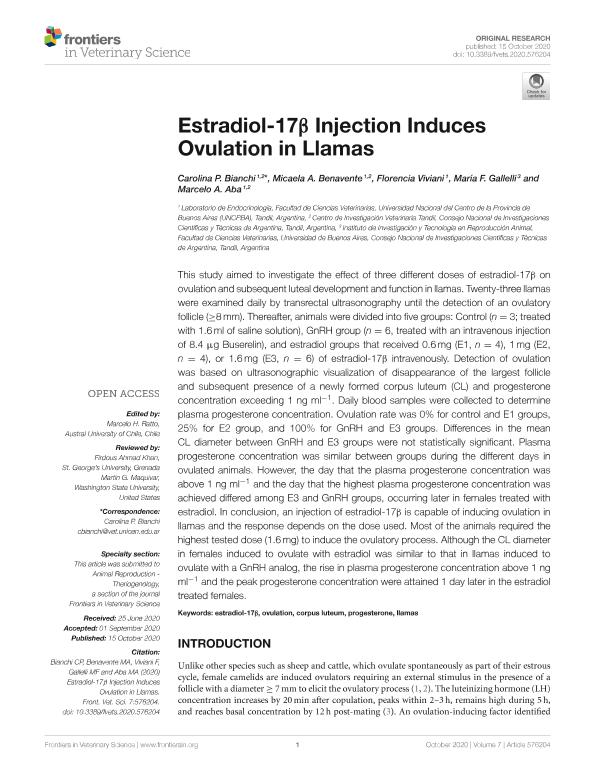Artículo
Estradiol-17β Injection Induces Ovulation in Llamas
Bianchi, Carolina Paula ; Benavente, Micaela Andrea
; Benavente, Micaela Andrea ; Viviani, Florencia; Gallelli, Maria Florencia
; Viviani, Florencia; Gallelli, Maria Florencia ; Aba, Marcelo Alfredo
; Aba, Marcelo Alfredo
 ; Benavente, Micaela Andrea
; Benavente, Micaela Andrea ; Viviani, Florencia; Gallelli, Maria Florencia
; Viviani, Florencia; Gallelli, Maria Florencia ; Aba, Marcelo Alfredo
; Aba, Marcelo Alfredo
Fecha de publicación:
10/2020
Editorial:
Frontiers Media S.A.
Revista:
Frontiers in Veterinary Science
ISSN:
22971769
e-ISSN:
2297-1769
Idioma:
Inglés
Tipo de recurso:
Artículo publicado
Clasificación temática:
Resumen
This study aimed to investigate the effect of three different doses of estradiol-17b onovulation and subsequent luteal development and function in llamas. Twenty-three llamaswere examined daily by transrectal ultrasonography until the detection of an ovulatoryfollicle (≥8mm). Thereafter, animals were divided into five groups: Control (n = 3; treatedwith 1.6ml of saline solution), GnRH group (n = 6, treated with an intravenous injectionof 8.4 μg Buserelin), and estradiol groups that received 0.6mg (E1, n = 4), 1mg (E2,n = 4), or 1.6mg (E3, n = 6) of estradiol-17b intravenously. Detection of ovulationwas based on ultrasonographic visualization of disappearance of the largest follicleand subsequent presence of a newly formed corpus luteum (CL) and progesteroneconcentration exceeding 1 ng ml−1. Daily blood samples were collected to determineplasma progesterone concentration. Ovulation rate was 0% for control and E1 groups,25% for E2 group, and 100% for GnRH and E3 groups. Differences in the meanCL diameter between GnRH and E3 groups were not statistically significant. Plasmaprogesterone concentration was similar between groups during the different days inovulated animals. However, the day that the plasma progesterone concentration wasabove 1 ng ml−1 and the day that the highest plasma progesterone concentration wasachieved differed among E3 and GnRH groups, occurring later in females treated withestradiol. In conclusion, an injection of estradiol-17b is capable of inducing ovulation inllamas and the response depends on the dose used. Most of the animals required thehighest tested dose (1.6mg) to induce the ovulatory process. Although the CL diameterin females induced to ovulate with estradiol was similar to that in llamas induced toovulate with a GnRH analog, the rise in plasma progesterone concentration above 1 ngml−1 and the peak progesterone concentration were attained 1 day later in the estradioltreated females.
Palabras clave:
CORPUS LUTEUM
,
ESTRADIOL-17Β
,
LLAMAS
,
OVULATION
,
PROGESTERONE
Archivos asociados
Licencia
Identificadores
Colecciones
Articulos(CIVETAN)
Articulos de CENTRO DE INVESTIGACION VETERINARIA DE TANDIL
Articulos de CENTRO DE INVESTIGACION VETERINARIA DE TANDIL
Citación
Bianchi, Carolina Paula; Benavente, Micaela Andrea; Viviani, Florencia; Gallelli, Maria Florencia; Aba, Marcelo Alfredo; Estradiol-17β Injection Induces Ovulation in Llamas; Frontiers Media S.A.; Frontiers in Veterinary Science; 7; 10-2020; 1-6
Compartir
Altmétricas



